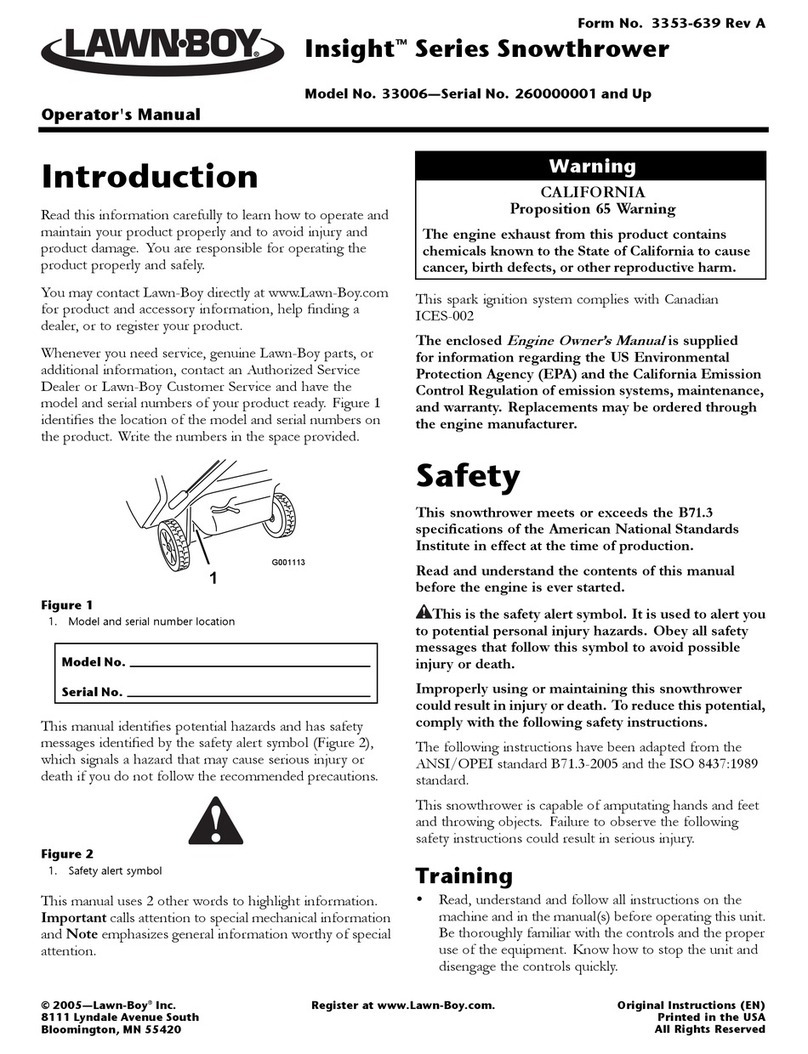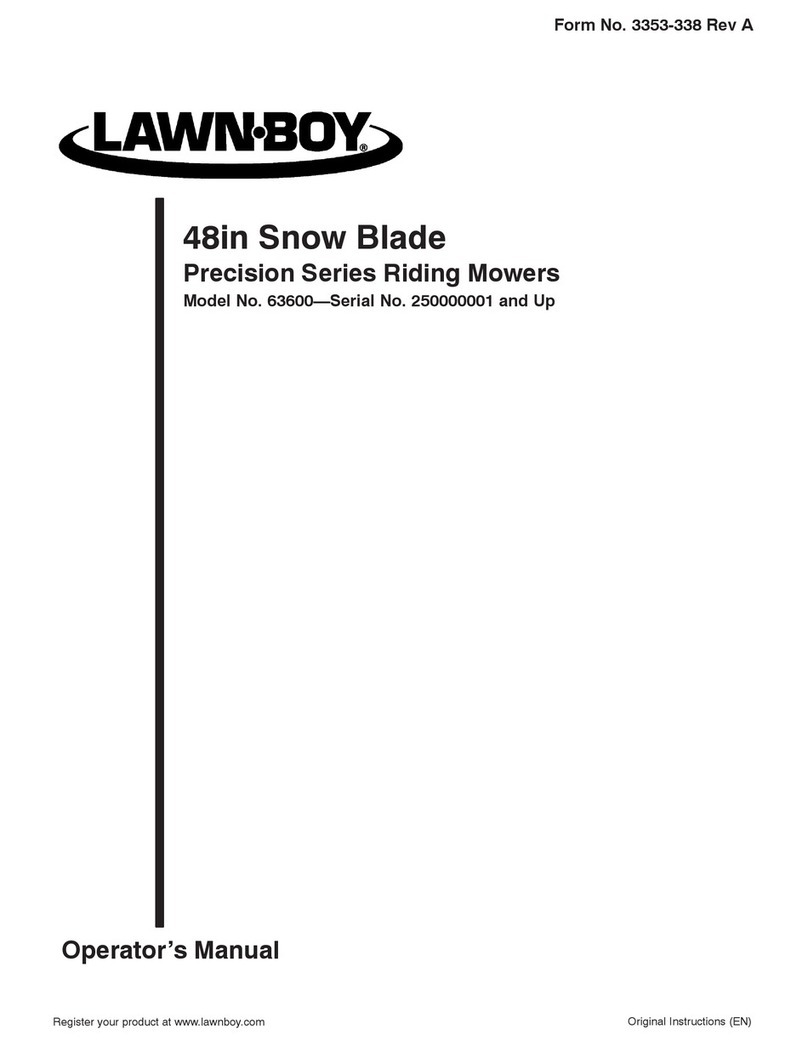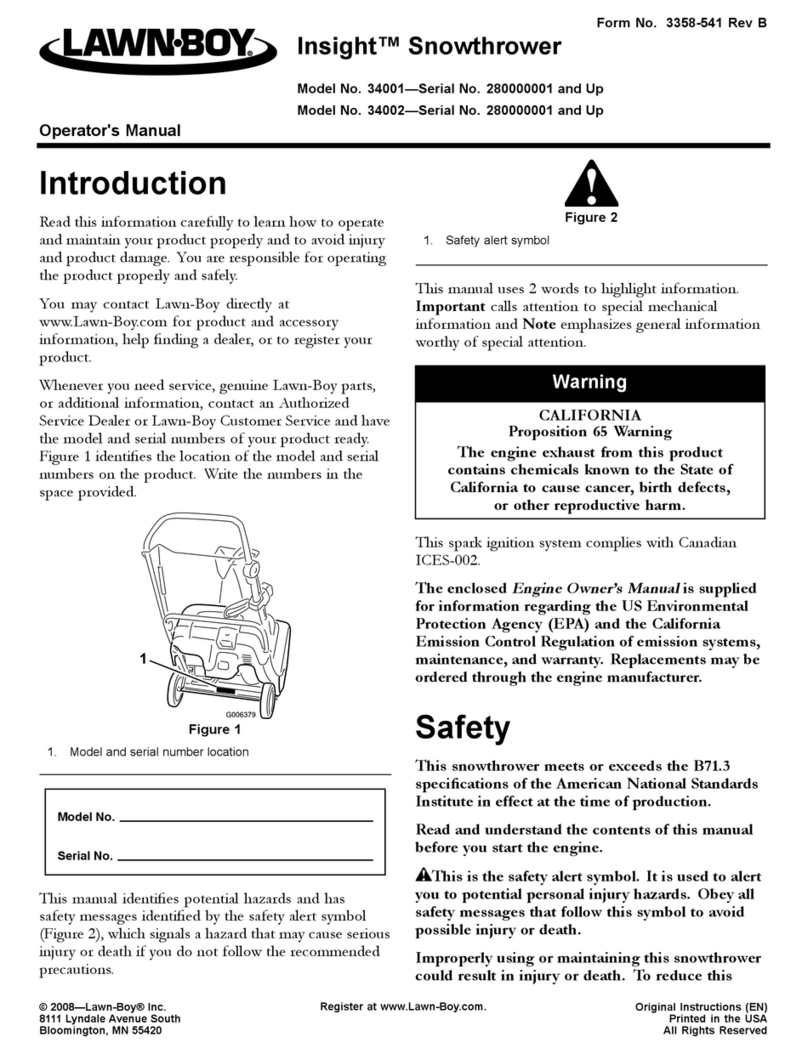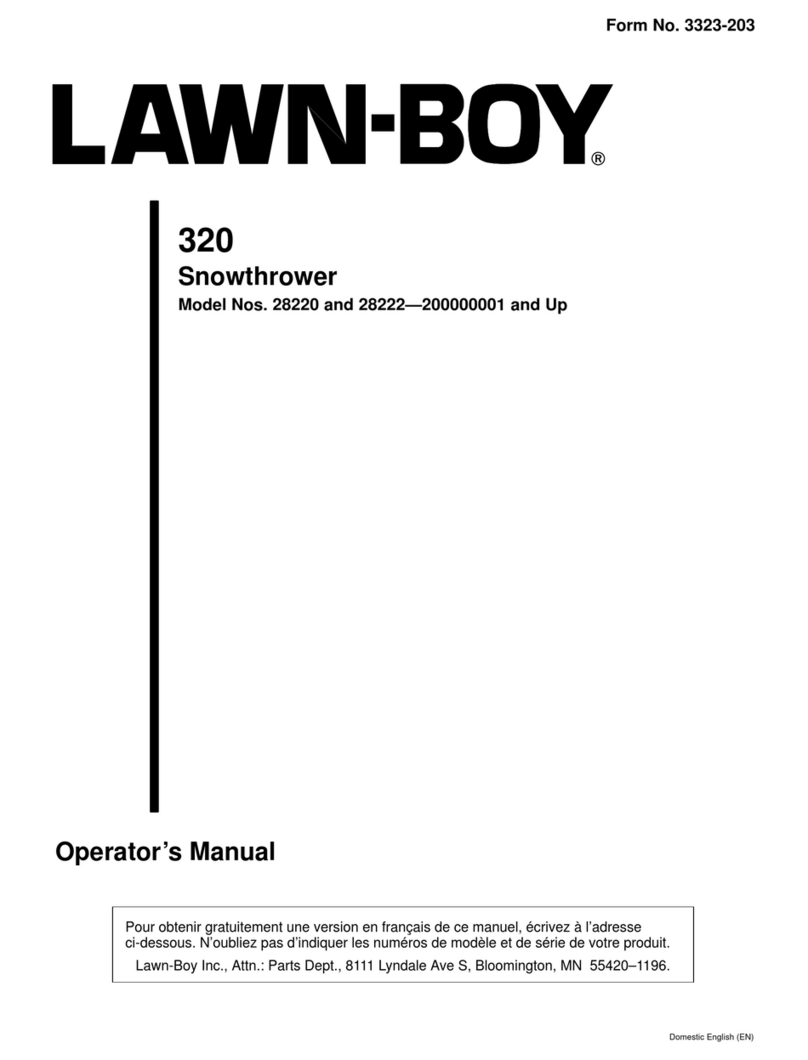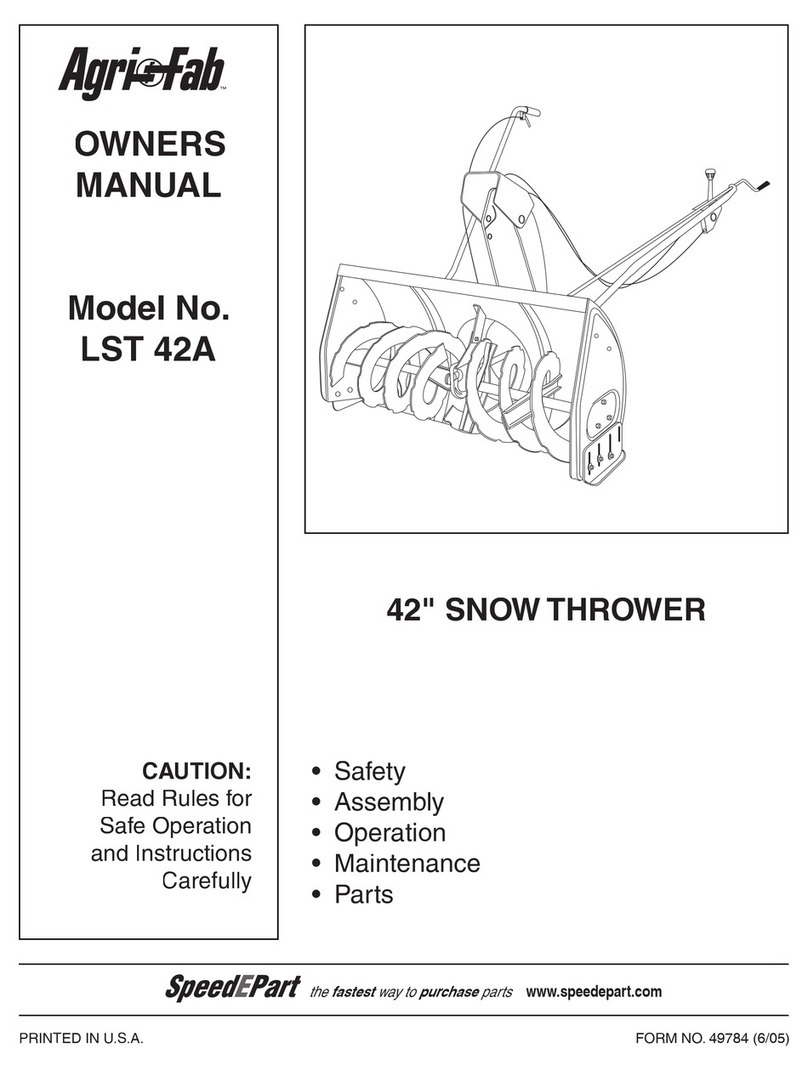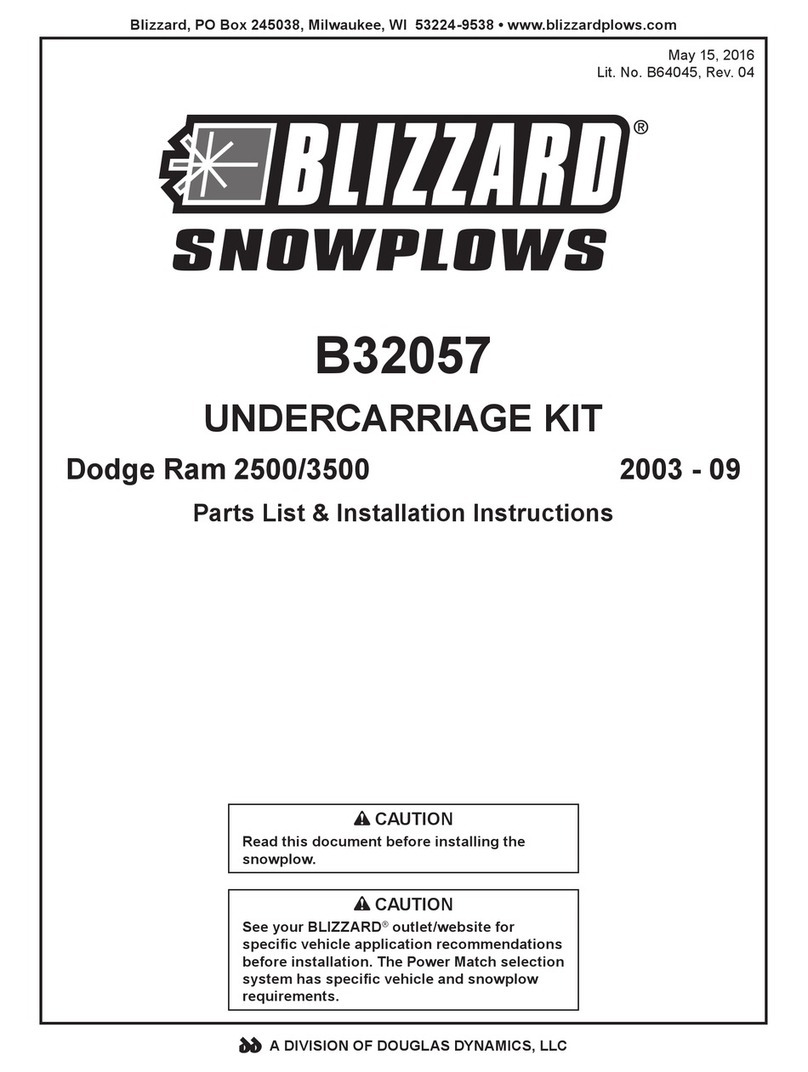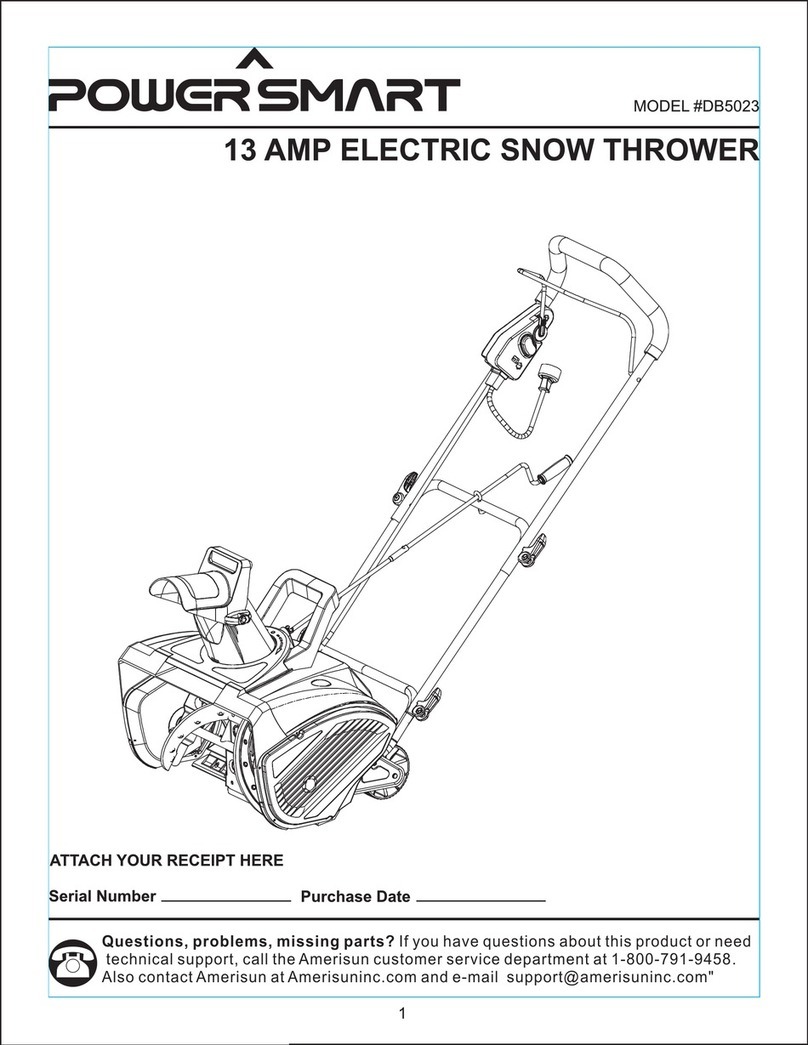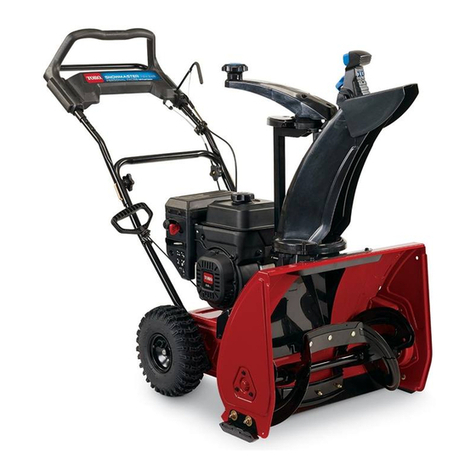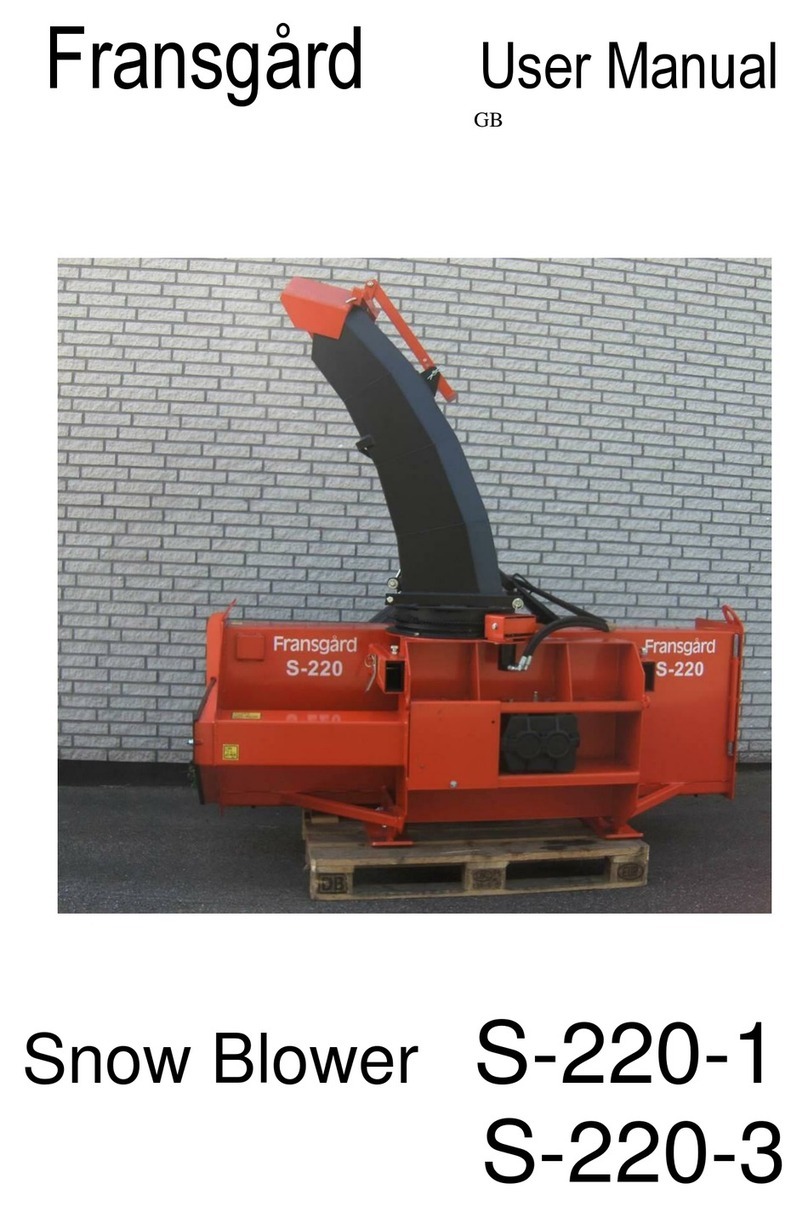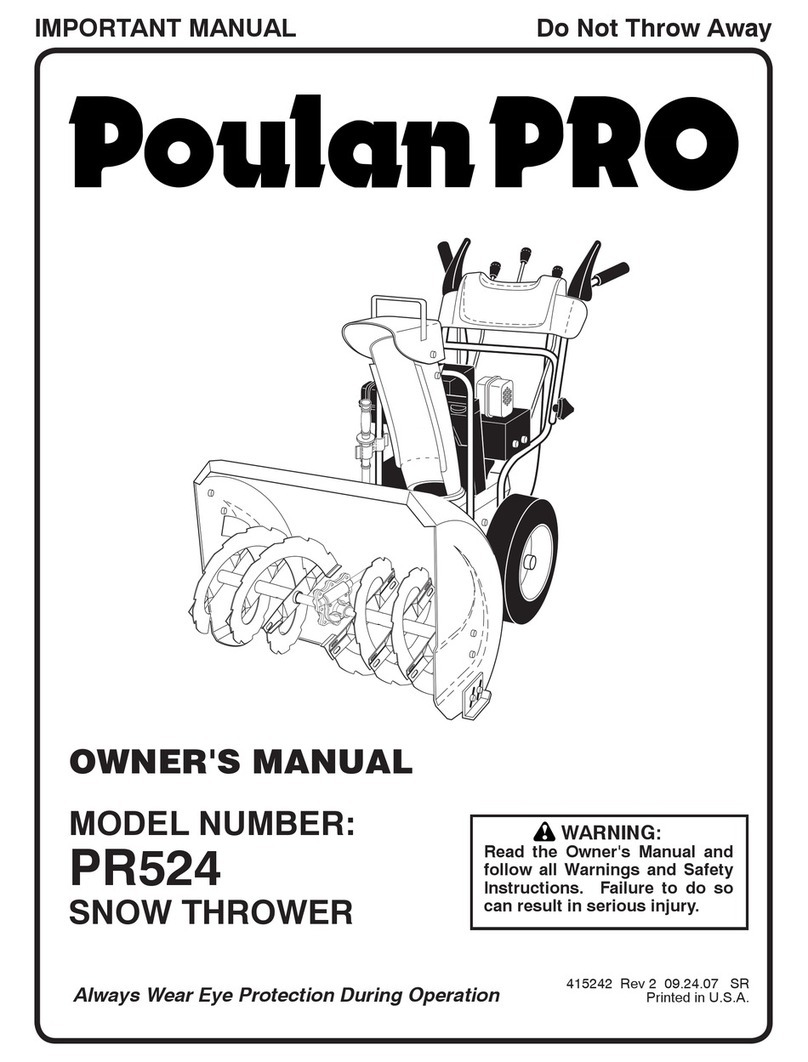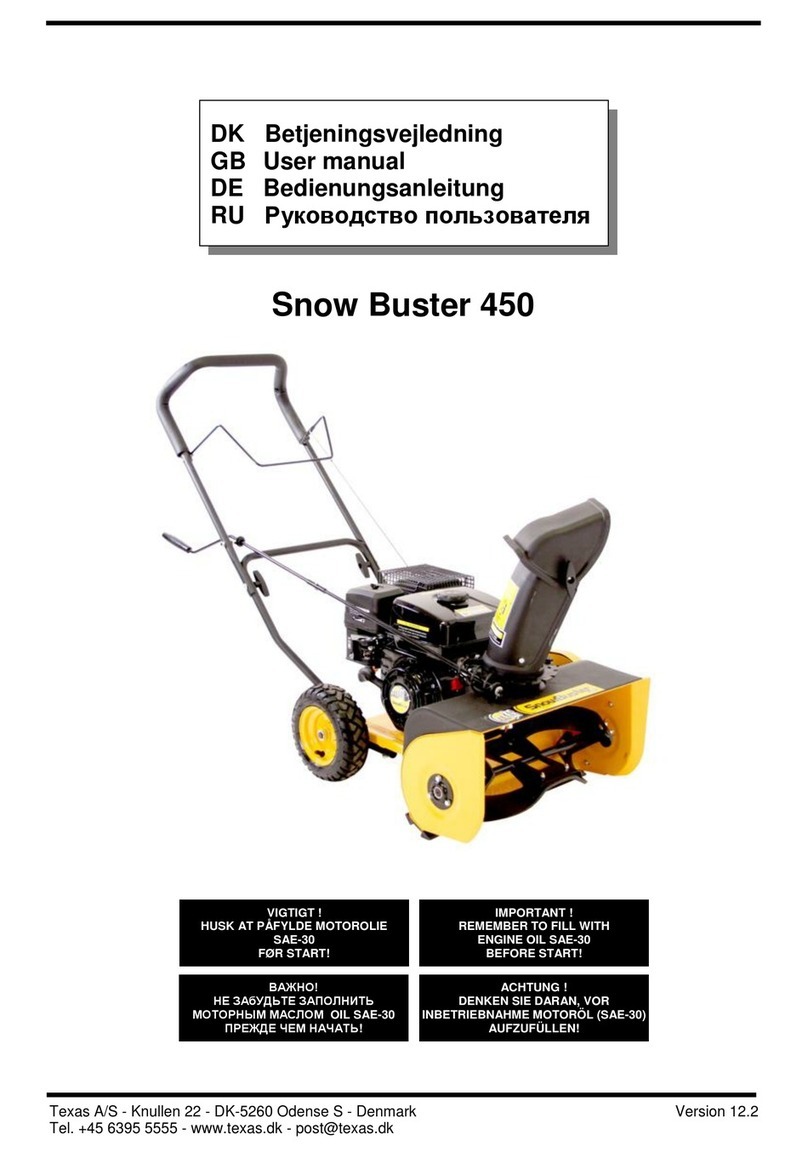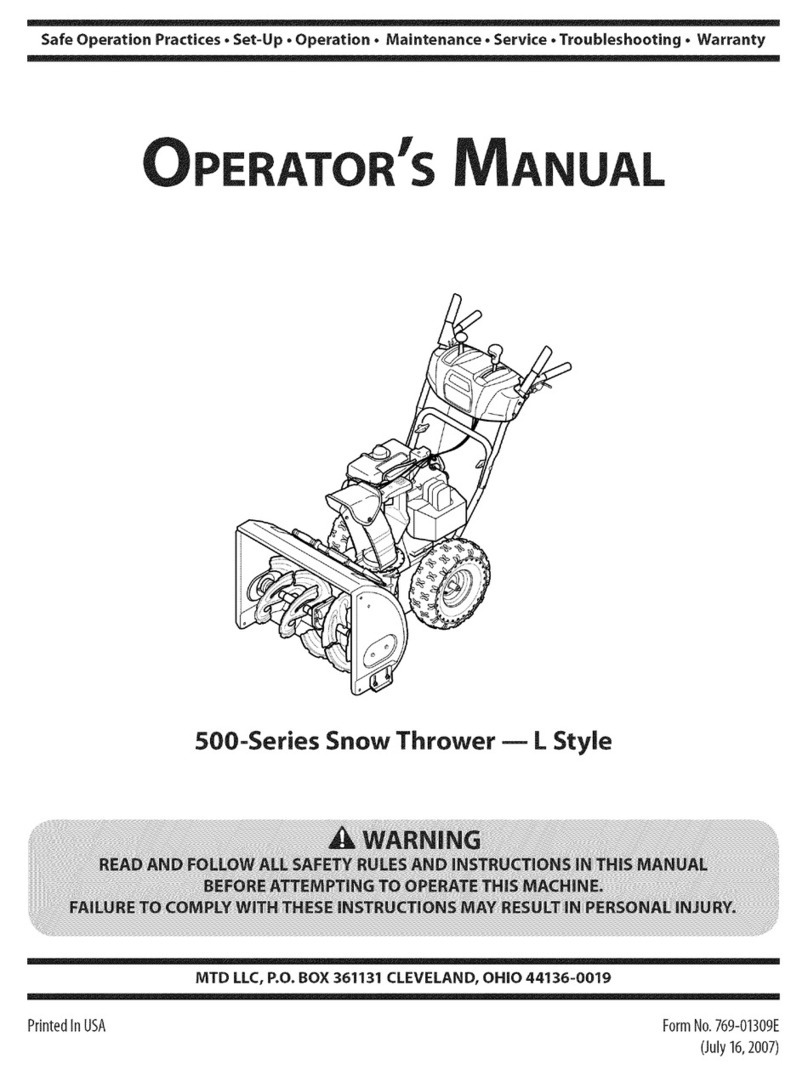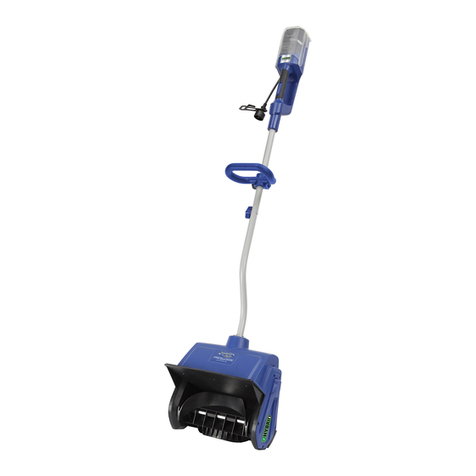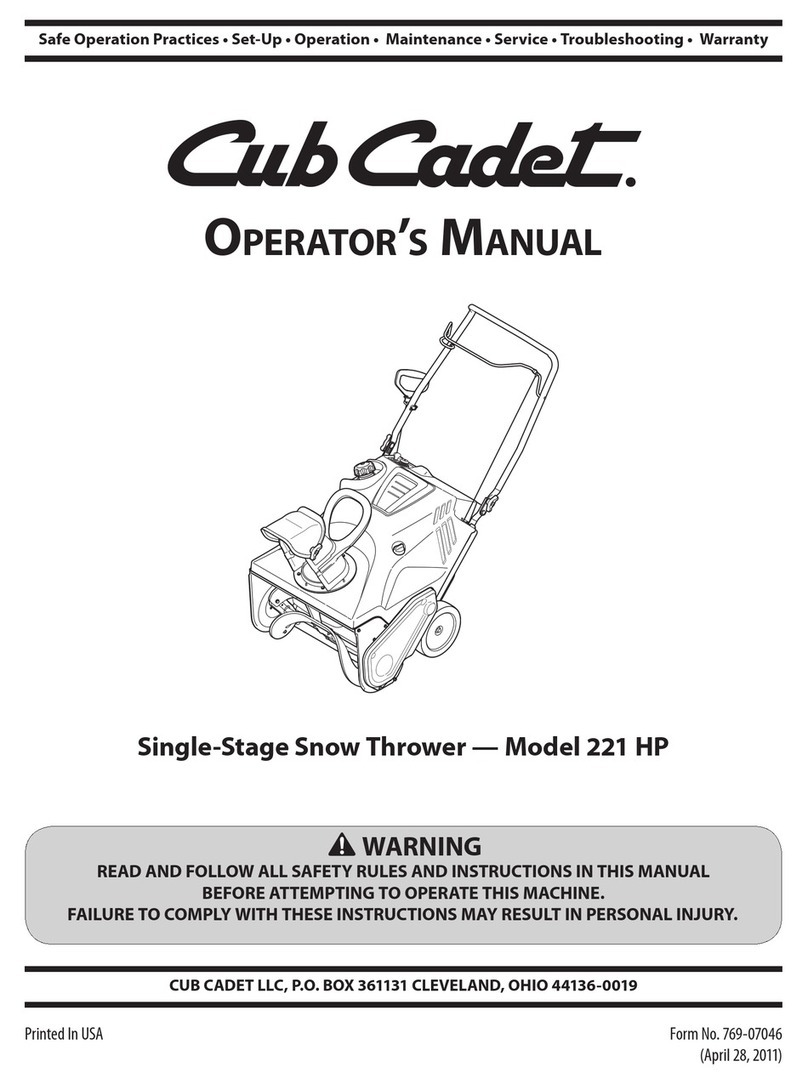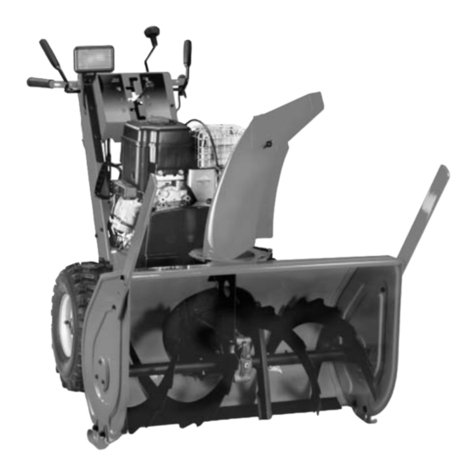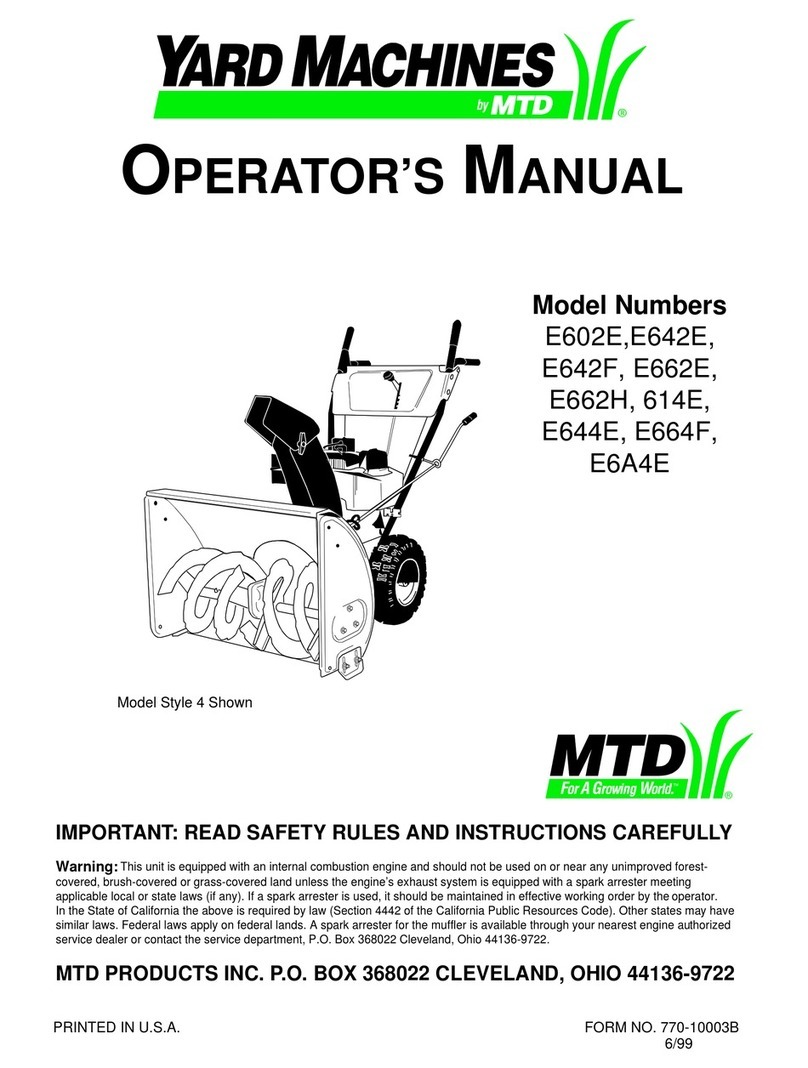Lawn-Boy 520R User manual

Operator’s Manual
Domestic English (EN)
Form No. 3326-623 Rev B
520R and 720E
Snowthrower
Model No. 28225—220000001 and Up
Model No. 28226—220000001 and Up

2003 by Lawn-Boy, Inc.
All Rights Reserved Printed in USA
2
The engine exhaust from this product contains
chemicals known to the State of California to
cause cancer, birth defects, or other reproductive
harm.
Warning
Important This engine is not equipped with a spark
arrester muffler. It is a violation of California Public
Resource Code Section 4442 to use or operate this engine
on any forest-covered, brush-covered, or grass-covered
land. Other states or federal areas may have similar laws.
This spark ignition system complies with Canadian
ICES-002.
Ce système d’allumage par étincelle de véhicule est
conforme à la norme NMB-002 du Canada.
Contents
Page
Introduction 2. . . . . . . . . . . . . . . . . . . . . . . . . . . . . . . .
Safety 3. . . . . . . . . . . . . . . . . . . . . . . . . . . . . . . . . . . . .
Safe Operating Practices 3. . . . . . . . . . . . . . . . . . .
Lawn-Boy Snowthrower Safety 4. . . . . . . . . . . . . .
Safety and Instruction Decals 5. . . . . . . . . . . . . . .
Assembly 6. . . . . . . . . . . . . . . . . . . . . . . . . . . . . . . . . .
Loose Parts 6. . . . . . . . . . . . . . . . . . . . . . . . . . . . . .
Unfolding the Handle 7. . . . . . . . . . . . . . . . . . . . . .
Installing the Discharge Chute 8. . . . . . . . . . . . . . .
Installing the Chute Crank 8. . . . . . . . . . . . . . . . . .
Before Starting 9. . . . . . . . . . . . . . . . . . . . . . . . . . . . . .
Mixing Gasoline and Oil 9. . . . . . . . . . . . . . . . . . .
Filling the Fuel Tank 10. . . . . . . . . . . . . . . . . . . . . .
Reviewing the Maintenance Schedule 10. . . . . . . . .
Operation 10. . . . . . . . . . . . . . . . . . . . . . . . . . . . . . . . . .
Operating Controls 10. . . . . . . . . . . . . . . . . . . . . . . .
Starting the Engine 10. . . . . . . . . . . . . . . . . . . . . . . .
Stopping the Engine 11. . . . . . . . . . . . . . . . . . . . . . .
Starting the Rotor Blades 11. . . . . . . . . . . . . . . . . . .
Stopping the Rotor Blades 11. . . . . . . . . . . . . . . . . .
Adjusting the Discharge Chute 11. . . . . . . . . . . . . .
Snowthrowing Tips 11. . . . . . . . . . . . . . . . . . . . . . .
Maintenance 12. . . . . . . . . . . . . . . . . . . . . . . . . . . . . . . .
Recommended Maintenance Schedule 12. . . . . . . .
Adjusting the Control Cable 12. . . . . . . . . . . . . . . .
Replacing the Scraper 13. . . . . . . . . . . . . . . . . . . . .
Replacing the Rotor Blades 14. . . . . . . . . . . . . . . . .
Page
Replacing the Spark Plug 15. . . . . . . . . . . . . . . . . . .
Replacing the Drive Belt 16. . . . . . . . . . . . . . . . . . .
Emptying the Fuel Tank 16. . . . . . . . . . . . . . . . . . . .
Storage 17. . . . . . . . . . . . . . . . . . . . . . . . . . . . . . . . . . . .
Preparing the Fuel System 17. . . . . . . . . . . . . . . . . .
Preparing the Engine 17. . . . . . . . . . . . . . . . . . . . . .
Preparing the Snowthrower 17. . . . . . . . . . . . . . . . .
Folding the Handle 17. . . . . . . . . . . . . . . . . . . . . . . .
Troubleshooting 18. . . . . . . . . . . . . . . . . . . . . . . . . . . . .
The Lawn-Boy Worry Free Five-Year Starting
Guarantee 20. . . . . . . . . . . . . . . . . . . . . . . . . . . . . . . .
Federal Emission Control Warranty Statement 22. . . . .
A Two-Year Full Warranty 24. . . . . . . . . . . . . . . . . . . .
Warning
The engine exhaust from this product contains
chemicals known to the State of California to
cause cancer, birth defects, or other reproductive
harm.
Introduction
Read this manual carefully to learn how to operate and
maintain your product properly. The information in this
manual can help you and others avoid injury and product
damage. Although Lawn-Boy designs and produces safe
products, you are responsible for operating the product
properly and safely.
Whenever you need service, genuine Lawn-Boy parts, or
additional information, contact an Authorized Service
Dealer or Lawn-Boy Customer Service and have the
model and serial numbers of your product ready. Figure 1
illustrates the location of the model and serial numbers on
the product.
637
1
Figure 1
1. Modelnumber and serial number decal

3
Write the product model and serial numbers in the space
below:
Model No.
Serial No.
This manual identifies potential hazards and has special
safety messages that help you and others avoid personal
injury and even death. Danger, Warning, and Caution are
signal words used to identify the level of hazard.
However, regardless of the hazard, be extremely careful.
Danger signals an extreme hazard that will cause serious
injury or death if you do not follow the recommended
precautions.
Warning signals a hazard that may cause serious injury or
death if you do not follow the recommended precautions.
Caution signals a hazard that may cause minor or
moderate injury if you do not follow the recommended
precautions.
This manual uses 2 other words to highlight information.
Important calls attention to special mechanical
information and Note: emphasizes general information
worthy of special attention.
Safety
Model 28226 meets or exceeds the B71.3 specifications
of the American National Standards Institute in effect
at the time of production.
To ensure maximum safety and best performance, and
to gain knowledge of the product, it is essential that
you and any other operator of the snowthrower read
and understand the contents of this manual before the
engine is ever started.
This is the safety alert symbol. It is used to alert
you to potential personal injury hazards. Obey all
safety messages that follow this symbol to avoid
possible injury or death.
Improperly using or maintaining this snowthrower
could result in injury or death. To reduce this potential,
comply with the following safety instructions.
Safe Operating Practices
The following instructions have been adapted from the
ANSI/OPEI B71.3–1995 standard and the ISO 8437:1989
standard.
Training
•Read the operator’s manual carefully. Be thoroughly
familiar with the controls and the proper use of the
equipment. Know how to stop the unit and disengage
the controls quickly.
•Never allow children to operate the snowthrower.
Never allow adults to operate the snowthrower without
proper instruction.
•Keep the area of operation clear of all persons
(particularly small children) and pets.
•Exercise caution to avoid slipping or falling.
Preparation
•Thoroughly inspect the area where you will use the
snowthrower. Remove all doormats, sleds, boards,
wires, and other foreign objects.
•Release the control bar to disengage the rotor blades
before starting the engine.
•Do not operate the snowthrower without wearing
adequate winter garments. Wear footwear that will
improve your footing on slippery surfaces.
•Handle fuel with care; it is highly flammable.
– Use an approved fuel container.
– Never add fuel to a running or hot engine.
– Fill the fuel tank outdoors with extreme care.
Never fill the fuel tank indoors.
– Replace the fuel tank cap securely and wipe up any
spilled fuel.
•Use only the power cord supplied with the
snowthrower and a receptacle appropriate for use with
the power cord for electric-start motors.
•Never attempt to make any adjustments while the
engine is running, except where specifically
recommended by Lawn-Boy.
•Let the engine and the snowthrower adjust to the
outdoor temperature before starting to clear snow.
•Operating any powered machine can result in foreign
objects being thrown into the eyes. Always wear safety
glasses or eye shields while operating, adjusting, or
repairing the snowthrower.
Operation
•Do not put hands or feet near or under rotating parts.
Keep clear of the discharge opening at all times.
•Exercise extreme caution when crossing gravel drives,
walks, or roads. Stay alert for hidden hazards or traffic.

4
•Do not attempt to clear snow from a crushed-rock or
gravel surface. This product is intended for use only on
paved surfaces.
•After striking a foreign object, stop the engine, remove
the ignition key, thoroughly inspect the snowthrower
for any damage, and repair the damage before
operating the snowthrower.
•If the unit should start to vibrate abnormally, stop the
engine and check immediately for the cause. Vibration
is generally a warning of trouble.
•Stop the engine whenever you leave the operating
position, before unclogging the discharge chute, and
when making any repairs, adjustments, or inspections.
•When cleaning, repairing, or inspecting, make certain
that the rotor blades and all moving parts have
stopped.
•Do not run the engine indoors, except when starting it
and for moving the snowthrower in or out of the
building. Open the outside doors; exhaust fumes are
dangerous.
•Do not clear snow across the face of slopes. Exercise
extreme caution when changing direction on slopes.
Do not attempt to clear steep slopes.
•Never operate the snowthrower without proper guards,
plates, or other safety protective devices in place.
•Never operate the snowthrower near glass enclosures,
automobiles, window wells, and drop-offs without
properly adjusting the snow discharge angle. Keep
children and pets away.
•Do not overload the machine capacity by attempting to
clear snow at too fast a rate.
•Look behind and use care when backing up with the
snowthrower.
•Never direct the discharge at bystanders or allow
anyone in front of the unit.
•Never operate the snowthrower without good visibility
or light. Always be sure of your footing, and keep a
firm hold on the handle. Walk; never run.
Maintenance and Storage
•Check all fasteners at frequent intervals for proper
tightness to be sure that the equipment is in safe
working condition.
•Never store the machine with fuel in the fuel tank
inside a building where ignition sources are present,
such as hot water and space heaters and clothes dryers.
Allow the engine to cool before storing in any
enclosure.
•Always refer to this operator’s manual for important
details if the snowthrower is to be stored for an
extended period.
•Maintain or replace safety and instruction labels when
necessary.
Lawn-Boy Snowthrower Safety
The following list contains safety information specific to
Lawn-Boy products or other safety information that you
must know.
•Rotating rotor blades can injure fingers or hands. Stay
behind the handles and away from the discharge
opening while operating the snowthrower. Keep your
face, hands, feet, and any other part of your body or
clothing away from moving or rotating parts.
•Before adjusting, cleaning, repairing, and inspecting
the snowthrower, and before unclogging the discharge
chute, stop the engine, remove the key, and wait for all
moving parts to stop.
•Use a stick, not your hands, to remove obstructions
from the discharge chute.
•Before leaving the operating position, stop the engine,
remove the key, and wait for all moving parts to stop.
•Do not wear loose-fitting clothing that could get
caught in moving parts.
•If a shield, safety device, or decal is damaged,
illegible, or lost, repair or replace it before beginning
operation. Also, tighten any loose fasteners.
•Do not smoke while handling gasoline.
•Do not use the snowthrower on a roof.
•Do not touch the engine while it is running or soon
after it has stopped because the engine may be hot
enough to cause a burn.
•Perform only those maintenance instructions described
in this manual. Before performing any maintenance,
service, or adjustment, stop the engine, remove the
key, and disconnect the wire from the spark plug. If
major repairs are ever needed, contact your Authorized
Service Dealer.
•Do not change the governor settings on the engine.
•When storing the snowthrower for more than 30 days,
drain the fuel from the fuel tank to prevent a potential
hazard. Store fuel in an approved fuel container.
Remove the key from the ignition switch before
storing the snowthrower.
•To ensure the best performance and safety, purchase
only genuine Lawn-Boy replacement parts and
accessories.

5
Safety and Instruction Decals
Safety decals and instructions are easily visible to the operator and are located near any
area of potential danger. Replace any decal that is damaged or lost.
60-9480
61-4790 (Model 28226)
104-2767
104-2775
104-4135
105-2963 (Model 28225)

6
105-2964 (Model 28226)
French translation of U.S. EPA decal text:
Ce moteur est conforme
à la réglementation
antipollution Phase EPA
relative aux moteurs
ULGE.
Famille :
XXXXX.XXXXXX
Nº de modèle :
XXX–XXXX
CYLINDREE (CC) : 141
Pour plus de détails sur la
sécurité, l’entretien et les
réglages, reportez-vous au
manuel de l’utilisateur. Nº
de téléphone des services
de vente et d’après-vente
aux Etats-Unis :
1-800-526-6937
Lawn-Boy, Inc.
Bloomington, MN
INFORMATION
IMPORTANTE
CONCERNANT LE
MOTEUR
Assembly
Note: Determine the left and right sides of the snowthrower by standing in the normal operating position.
Loose Parts
DESCRIPTION QTY. USE
Carriage bolts
Locknuts
Washers
Discharge chute
3
3
3
1
Installing the discharge chute
Screws
Locknuts
Chute crank and mounting bracket
2
2
1Installing the chute crank (Model 28226 only)
Ignition key 1Starting and stopping the engine

7
Unfolding the Handle
1. Cut the tie that secures the control cable to the handle.
2. Loosen the knobs and pull out the handle locks until
the upper handle rotates freely (Fig. 3).
3. Position the upper handle as shown in Figure 2.
m4522
1
Figure 2
1. Upperhandle
Note: Make sure that the cable guide is in the position as
shown in Figure 3.
m4523
12
3
Figure 3
1. Knob
2. Cableguide 3. Handle lock
4. Install the control cable to the control bar.
Model 28225
Squeeze the control bar together and remove it from
the handle. Insert the loose end of the control cable
into the bottom hole of the control bar as illustrated in
Figure 4, and squeeze the control bar and insert it into
the handle.
1
2
5
4
m-5533/m-2708
1
2
3
6
4
Figure 4
1. Top hole
2. Bottom hole
3. 1/16 to 1/8 inch (2 to
3 mm) gap
4. Control bar
5. Spring cover
6. Control cable
5. Fully insert the handle locks.
6. Tighten the knobs until they are snug.
7. Ensure that a 1/16 to 1/8 inch (2 to 3 mm) gap exists
between the control bar and the handle (Refer to
Adjusting the Control Cable on page 12).
Model 28226
1. Insert the loose end of the control cable into the
bottom hole of the control bar as illustrated in
Figure 5.
m-5519
4
3
2
15
Figure 5
1. Cable
2. Controlbar
3. Top hole
4. Bottom hole
5. 1/16 to 1/8 inch (2 to
3 mm) gap
2. Ensure that a 1/16 to 1/8 inch (2 to 3 mm) gap exists
between the control bar and the handle (Refer to
Adjusting the Control Cable on page 12).

8
Installing the Discharge Chute
Model 28225 only
1. Place the chute handle over the chute ring (Fig. 6).
m-3277
2
1
6
34
5
Figure 6
1. Carriagebolt (3)
2. Chute ring
3. Discharge chute
4. Chute handle
5. Washer (3)
6. Locknut (3)
2. Insert the discharge chute between the chute ring and
the chute handle. (Fig. 6).
3. Align the hole in the back of the chute with the center
hole in the ring.
Note: You can rotate the chute ring for easier
assembly.
4. Install a carriage bolt, a washer, and a locknut through
the center holes, with the washer and the locknut on
the outside.
5. Install the carriage bolts, the washers, and the locknuts
through the remaining holes, with the washers and the
locknuts on the outside.
6. Tighten all locknuts securely.
Models 28226 only
1. Set the discharge chute over the chute ring (Fig. 7).
2
1
636a
Figure 7
1. Dischargechute 2. Chute ring
2. Align the hole in the back of the chute with the center
hole in the ring (Fig. 7).
3. Install a screw, a washer, and a locknut through the
center holes, with the locknut on the outside (Fig. 7).
Note: You can rotate the chute ring for easier
assembly.
4. Install the screws, washers, and locknuts through the
remaining holes, with the locknuts on the outside.
5. Tighten all locknuts securely.
Installing the Chute Crank
Model 28226 only
1. Insert the flattened end of the chute crank through the
hole in the shroud while aligning the mounting bracket
with the holes in the lower handle (Fig. 8).
893
635
3
1
2
45
Figure 8
1. Chute crank
2. Mounting bracket
3. Gear
4. Plastic bushing
5. Hidden gear opening
2. Slowly rotate the crank until the flattened end fits into
the hidden gear opening and the chute ring turns with
the crank (Fig. 8).
3. Fully insert the plastic bushing into the hole in the
mounting bracket (Fig. 8).
4. Secure the mounting bracket to the handle with 2
screws and locknuts (Fig. 8).

9
Before Starting
Mixing Gasoline and Oil
Your Lawn-Boy snowthrower is powered by a 2-cycle
engine that requires a 50:1 gasoline-to-oil mixture.
Use only clean, unleaded gasoline no more than 30 days
old and with an octane rating of 87 or higher. Using
unleaded gasoline reduces combustion chamber deposits
and promotes longer spark plug life.
Engines certified to comply with U.S. EPA emission
regulations for ULGE engines are certified to operate on a
mixture of regular unleaded gasoline and oil, include the
following emission control system(s): EM and TWC (if
equipped), and do not include any user-adjustable
features.
Important Do not use methanol, gasoline containing
methanol, gasohol containing more than 10% ethanol,
premium gasoline, or white gas. Using these fuels can
damage the fuel system.
Important Do not use an automotive oil (such as SAE
30 or 10W30), a 2-cycle oil that is not NMMA
TCW-certified, or a fuel mixed at the wrong
gasoline-to-oil ratio. This can cause engine damage not
covered under the Lawn-Boy warranty.
Danger
In certain conditions, gasoline is extremely
flammable and highly explosive. A fire or
explosion from gasoline can burn you and others
and can damage property.
•Fill the fuel tank outdoors, in an open area, and
when the engine is cold. Wipe up any gasoline
that spills.
•Do not fill the fuel tank completely full. Add
gasoline to the fuel tank until the level is 1/4 to
1/2 in. (6 to 13 mm) below the bottom of the
filler neck. This empty space in the tank allows
the gasoline to expand.
•Never smoke when handling gasoline, and stay
away from an open flame or where a spark may
ignite the gasoline fumes.
•Store gasoline in an approved fuel container
and keep it out of the reach of children.
•Never buy more than a 30-day supply of
gasoline.
Danger
When fueling, under certain circumstances, a
static charge can develop, igniting the gasoline. A
fire or explosion from gasoline can burn you and
others and damage property.
•Always place gasoline containers on the ground
and away from your vehicle before filling.
•Do not fill gasoline containers inside a vehicle
or on a truck or trailer bed because interior
carpets or plastic truck bed liners may insulate
the container and slow the loss of any static
charge.
•When practical, remove gasoline-powered
equipment from the truck or trailer and refuel
the equipment with its wheels on the ground.
•If this is not possible, then refuel such
equipment on a truck or trailer from a portable
container, not from a gasoline dispenser nozzle.
•If you must use a gasoline dispenser nozzle,
keep the nozzle in contact with the rim of the
fuel tank or container opening at all times until
fueling is complete.
Note: Use a fuel stabilizer/conditioner for all Lawn-Boy
gasoline-powered products during operation and storage.
A fuel stabilizer/conditioner cleans the engine during
operation and prevents gum-like varnish deposits from
forming in the engine during storage. A fuel
stabilizer/conditioner works best when you mix it with
fresh gasoline. If you use Lawn-Boy Generation II 2-Cycle
Oil (Fuel Stabilizer Added), you do not need to add a fuel
stabilizer/conditioner.
Important Do not use fuel additives except a fuel
stabilizer during storage. Do not use fuel stabilizers with
an alcohol base, such as ethanol, methanol, or
isopropanol.
1. Pour a half gallon (1.9 liters) of fresh, unleaded
gasoline into an approved fuel container.
Note: Do not mix gasoline and oil in the fuel tank. Oil at
room temperature mixes easier and more thoroughly than
cold oil. Oil below 32°F (0°C) requires additional mixing.
2. Add the full amount of Lawn-Boy Generation II
2-Cycle Oil (Fuel Stabilizer Added) or an equivalent
high grade, NMMA TCW-certified 2-cycle oil to the
gasoline according to the chart below:
50:1 Gasoline-to-Oil Ratio Mixing Chart
Gasoline Oil
1 gallon (4 liters) 2.6 ounces (80 ml)
2 gallons (8 liters) 5.2 ounces (160 ml)
8 liters 13 ounces (400 ml)

10
3. Install the cap on the fuel container.
4. Shake the container to mix the gasoline and oil
thoroughly.
5. Slowly remove the cap and add the remaining amount
of gasoline.
Filling the Fuel Tank
Important Do not overfill the fuel tank. The
gasoline-and-oil mixture must have room to expand.
1. Clean around the fuel tank cap; do not allow snow or
water to enter the fuel tank.
2. Remove the fuel tank cap and fill the fuel tank with
the gasoline-and-oil mixture until the level is 1/4 to
1/2 in. (6 to 13 mm) below the bottom of the filler
neck. Do not fill into the filler neck.
3. Install the fuel tank cap securely and wipe up any
spilled fuel.
Reviewing the Maintenance
Schedule
Review the Recommended Maintenance Schedule on
page 12. You may need to perform one or more additional
procedures before or soon after you begin operating the
snowthrower.
Operation
Operating Controls
The snowthrower control panel contains a key switch, a
primer, a recoil starter, and an electric start button
(electric start models only). The choke is just below the
control panel (Fig. 9).
2
3
5
4
6
642
1
Figure 9
1. Choke
2. Key switch
3. Primer
4. Recoil start
5. Electric start button
(electric-start model only)
6. Cord connection
(electric-start model only)
Starting the Engine
1. Turn the key to the On position and pull the choke out.
2. Cover the hole in the center of the primer with your
thumb and push the primer in twice. In extremely cold
temperatures, repeat this step as necessary.
Note: Do not use the choke and the primer when
starting a warm engine.
3. For a recoil starter: Hold the snowthrower with one
hand and pull the recoil starter vigorously with the
other hand.
For an electric starter:
A. Connect the power cord to the snowthrower and to
a standard household power outlet.
Caution
If you leave the snowthrower plugged into a
power outlet, someone can inadvertently start the
snowthrower and injure people or damage
property.
Unplug the power cord whenever you are not
starting the snowthrower.
B. Push the starter button.
Run the electric starter no more than 10 times at
intervals of 5 seconds on, then 5 seconds off. If the
engine does not start after this attempt, wait at least
40 minutes to allow the starter to cool before
attempting to start it again.

11
Important Running the electric starter extensively can
overheat and damage the starter.
If the engine does not start after the second
attempt, bring the snowthrower to an Authorized
Service Dealer for service.
C. When the engine starts, disconnect the power cord
from the snowthrower and the outlet.
4. With the engine running, push in the choke slowly.
Stopping the Engine
Turn the key to the Off position, and wait for all moving
parts to stop before leaving the operating position.
Starting the Rotor Blades
To start the rotor blades, squeeze the control bar and
handle together.
Stopping the Rotor Blades
Release the control bar to stop the rotor blades.
Note: When you release the control bar, the rotor blades
stop, but the engine continues to run.
Adjusting the Discharge Chute
Model 28225 only
Move the chute handle left and right to adjust the
direction of the snow stream (Fig. 10). The chute deflector
handle on top of the discharge chute controls the height of
the snow stream. Do not overtighten the chute deflector
mounting locknuts.
m-3278
23
1
Figure 10
1. Chutedeflector handle
2. Deflector mounting
locknuts
3. Chute handle
Important Do not use the chute handle to lift the
snowthrower. This can damage the chute handle.
Model 28226 only
Rotate the chute crank clockwise to move the discharge
chute to the right or counterclockwise to move the chute
to the left (Fig. 11). The chute deflector handle on top of
the discharge chute controls the height of the snow stream.
Do not overtighten the chute deflector mounting locknuts.
12
3
629
Figure 11
1. Chutedeflector handle
2. Deflector mounting
locknuts
3. Chute crank
Snowthrowing Tips
Warning
The rotor blades can throw stones, toys and other
foreign objects and cause serious personal injury
to the operator or to bystanders.
•Keep the area to be cleared free of all objects
that the rotor blades could pick up and throw.
•Keep all children and pets away from the area
of operation.
•Remove the snow as soon as possible after it falls.
This produces the best snow removal results.
•The snowthrower clears down to the ground and
propels itself forward when you raise the handle. The
snowthrower tilts slightly forward so that the rotor
blades strike the ground. The wheels do not need to
touch the ground to self-propel. The more you tilt the
handle forward, the faster the snowthrower
self-propels.
•If the snowthrower does not propel itself forward on
slippery surfaces or in heavy snow, push forward on
the handle, but allow the snowthrower to work at its
own pace.
•Overlap each swath to ensure complete snow removal.
•Discharge the snow downwind whenever possible.

12
•Do not attempt to clear snow from a crushed-rock or
gravel surface. This product is intended for use only on
paved surfaces.
•In snowy and cold conditions, some controls and
moving parts may freeze. Do not use excessive force
when trying to operate frozen controls. If you have
difficulty operating any control or part, start the engine
and let it run for a few minutes.
•After clearing the snow, let the engine run for a few
minutes to prevent moving parts from freezing. Shut
off the engine, wait for all moving parts to stop, and
remove all ice and snow from the snowthrower.
•With the engine off, pull the recoil starter handle
several times to prevent the recoil starter from freezing
up.
•For models with a chute crank, operate the chute crank
several times to remove any ice and snow.
Maintenance
Recommended Maintenance Schedule
Maintenance Service
Interval Maintenance Procedure
Initially •Check the control cable both initially and after the first hour of operation; adjust it
if necessary. Refer to Adjusting the Control Cable on page 12.
•Check for loose fasteners and tighten them if necessary.
Annually
•Check the control cable and adjust it if necessary. Refer to Adjusting the Control
Cable on page 12.
•Inspect the rotor blades and replace them if necessary. Replace the scraper
when you replace the rotor blades. Refer to Replacing the Rotor Blades on
page 14 and to Replacing the Scraper on page 13.
•Inspect the scraper and replace it if necessary. If the rotor blades are partially or
completely worn, replace the rotor blades when you replace the scraper. Refer to
Replacing the Scraper on page 13 and to Replacing the Rotor Blades on
page 14.
•Inspect the spark plug and check the gap; replace the spark plug if necessary.
Refer to Replacing the Spark Plug on page 15.
•Inspect the drive belt and replace it if necessary. Refer to Replacing the Drive
Belt on page 16.
•Store the snowthrower properly. Refer to Storage on page 17.
•Check for loose fasteners and tighten them if necessary.
Caution
If you leave the wire on the spark plug, someone could start the engine accidentally and
seriously injure you or other bystanders.
Disconnect the wire from the spark plug before you do any maintenance. Set the wire aside so
that it does not accidentally contact the spark plug.
Adjusting the Control Cable
Periodically check the control cable for proper
adjustment.
1. Stop the engine and wait for all moving parts to stop.
2. Move the control bar back toward the handle to
remove the slack in the cable (Fig. 4 or Fig. 5).
3. Make sure that a 1/16 to 1/8 inch (2 to 3 mm) gap
exists between the control bar and the handle Refer to
the inset in Figure 4 (model 28225) or in Figure 5
(model 28226). To adjust the cable, go to step 4.

13
Note: The control cable must have slack in it when
you disengage the control bar.
4. Adjust the cable as follows:
Model 28225 only:
A. Unhook the spring end from the bottom hole in the
control bar (Fig. 4).
B. Slide the spring cover off the spring and the cable
adjuster.
C. Unhook the Z–fitting from the cable adjuster
(Fig. 12) and position the Z–fitting in a higher or
lower hole on the adjuster to obtain a proper gap of
1/16 to 1/8 inch (2 to 3 mm) between the control
bar and the handle (Fig. 4).
897
1234
Figure 12
1. Cable
2. Z-fitting 3. Cableadjuster
4. Spring
D. Install the spring cover over the cable adjuster and
the spring.
E. Hook the spring into the bottom hole of the control
bar.
Model 28226 only:
A. Unhook the upper cable end from the hole in the
control bar (Fig. 5).
B. Slide the spring cover up the cable to expose the
cable adjuster (Fig. 13).
3
1630
2
Figure 13
1. Cableadjuster
2. Z–fitting 3. Spring cover
C. Unhook the Z–fitting from the cable adjuster
(Fig. 12) and position it in a higher or lower hole
on the adjuster to obtain a gap of 1/16 to 1/8 inch
(2 to 3 mm) between the control bar and the handle
(Fig. 5).
D. Install the spring cover over the cable adjuster.
E. Install the upper cable end into the bottom hole in
the control bar.
5. Check the adjustment (refer to steps 2 and 3 above).
After extended use, the drive belt may wear and lose its
proper belt tension. Improper belt tension causes the belt
to slip and decreases the performance under a heavy load.
Belt slippage may occur after 2 or 3 seasons of normal
usage (10 to 15 hours). If the drive belt slips (continuously
squeals) under a heavy load, increase the belt tension by
doing one of the following steps:
•For Model 28225: Position the spring end in the top
hole of the control bar (Fig. 4).
•For Models 28226: Position the upper cable end into
the upper hole of the control bar (Fig. 5).
Using the incorrect adjusting hole in the control bar can
reduce the drive belt life. Occasional belt slippage
(squealing) may occur in extremely wet conditions due to
moisture in the drive system. To remove moisture, start
the rotor and operate it without a load for 30 seconds.
Once you remove the moisture, the drive belt should not
slip.
Replacing the Scraper
Before each season, inspect the scraper for wear. If the
thickness of the scraper’s bottom is less than 1/16 inch
(2 mm), replace the scraper (Fig. 14).
634
2
1
Figure 14
1. Scraper 2. 1/16inch (2 mm)
Note: The running time and the roughness of the driveway
or sidewalk determines the scraper wear rate.
1. Stop the engine and wait for all moving parts to stop.
2. Remove the key from the switch.

14
3. Remove the 3 screws that secure the control panel to
the housing (Fig. 15).
643
1
2
Figure 15
1. Controlpanel 2. Mounting screws
4. Lift off the control panel and allow it to hang on the
recoil rope.
5. Disconnect the wire from the spark plug (Fig. 16).
1
628
Figure 16
1. Spark plug wire
6. Drain the fuel from the fuel tank. Refer to Emptying
the Fuel Tank on page 16.
7. Tip the snowthrower forward onto its front housing.
8. Remove the 3 carriage bolts and the locknuts that hold
the scraper in place (Fig. 17).
2
644
1
Figure 17
1. Scraper 2. Carriagebolts and
locknuts (3)
9. Remove the scraper by sliding it to the right and down.
10.Install the new scraper to the housing using the
carriage bolts and the locknuts.
11. Connect the wire to the spark plug.
12.Install the control panel with the screws.
13.Insert the key in the switch.
Replacing the Rotor Blades
Before each season, inspect the rotor blades for wear.
When a rotor blade edge has worn to the wear indicator
hole (Fig. 18), replace both rotor blades to ensure proper
performance and to prevent damage to the underside of
the snowthrower.
1
Figure 18
1. Wear indicator hole
Note: Replace the scraper whenever you replace the rotor
blades. This ensures proper snowthrower operation and
performance.

15
Note: The running time and the roughness of the driveway
or the sidewalk determines the wear rate of the rotor
blades.
Removing the Old Blade
Note: You will need a No. T27 torx driver to complete
this procedure.
1. Remove the 4 torx screws and the 4 locknuts that
secure the outer edges of the rotor blade to the rotor
shaft assembly (Fig. 19).
1
234
4
5
6
7
8680
Figure 19
1. Rotor blade
2. Rotor half
3. Torx screw
4. Locknut
5. Hex-head screw
6. Spacer
7. Auger shaft assembly
8. Hex-head screw
2. Remove the 2 hex-head screws, 2 spacers, and 2
locknuts that secure the center of the blade to the rotor
halves (Fig. 19).
3. Loosen the hex-head screw that secures the rotor
halves to the auger shaft assembly (Fig. 19).
4. Slide the blade out from between the rotor halves
(Fig. 19).
Installing a New Blade
1. Examine a new rotor blade edge for the difference in
layer thickness (Fig. 20). Some rotor blades have a
part number on the thick side of the blade.
3
1681
2
Figure 20
1. Thick layer
2. Wear indicator hole 3. Thin layer
Install the rotor blades with the thick layer on the
inside of the curve. (Fig. 20). If you do not install the
blades properly, the blades may be out of balance and
cause the snowthrower to “hop” or “bounce.”
2. Insert the new rotor blade between the rotor halves.
3. Secure the rotor blade to the rotor halves with 2
hex-head screws, 2 spacers, and 2 locknuts,
positioning the bolt heads on the thick side of the
blade (Fig. 19).
4. Curve the rotor blade and secure it with the remaining
torx screws and locknuts, positioning the screw heads
on the thick side of the blade (Fig. 19).
5. Tighten all screws and locknuts securely.
Replacing the Spark Plug
Before each season, check the spark plug. If the electrodes
in the center of the plug are dark or have deteriorated,
install a new NGK BPMR4A spark plug or equivalent.
1. Remove the 3 mounting screws that secure the control
panel to the housing (Fig. 15).
2. Remove the ignition key and lift off the panel,
allowing it to hang on the recoil rope.
3. Disconnect the wire from the spark plug and remove
the spark plug (Fig. 16).
4. Examine the spark plug and replace it if it is cracked,
fouled, or dirty.
Important Do not sandblast, scrape, or clean the spark
plug. Dirt may fall into the cylinder and cause engine
damage.
5. Set the spark plug gap (Fig. 21) between the electrodes
to 0.032 inches (0.81 mm).

16
1
m3215
Figure 21
1. 0.032in. (0.81 mm)
6. Install the spark plug and torque it to 15 ft-lb
(20.4 Nm). If you do not have a torque wrench,
tighten the plug firmly.
7. Connect the wire to the spark plug.
8. Install the control panel with the screws.
Replacing the Drive Belt
Inspect the drive belt before each season, and replace it if
it is worn or damaged.
1. Stop the engine and wait for all moving parts to stop.
2. Remove the key from the switch.
3. Remove the 3 screws that secure the control panel to
the housing (Fig. 15).
4. Lift off the control panel and allow it to hang on the
recoil rope.
5. Disconnect the wire from the spark plug (Fig. 16).
6. Remove the 3 self tapping screws, 2 screws, one
washer, and 2 locknuts that secure the belt cover to the
snowthrower frame (Fig. 22). Set the drive belt cover
aside.
1
23
4
631
Figure 22
1. Screw and locknut
2. Screw, locknut, and
washer
3. Long self-tapping screw
4. Short self-tapping screws
7. Pull up on the idler pulley and remove the drive belt
from the rotor pulley, the brake arm assembly, and the
engine pulley (Fig. 23).
4
21
6
3
5626
Figure 23
1. Enginepulley
2. Idler pulley
3. Roller
4. Brake arm assembly
5. Rotor pulley
6. Belt guide
8. Loop the new drive belt around the engine pulley,
under the idler pulley, over the roller, through the
brake assembly, and around the rotor pulley (Fig. 23).
Important The drive belt must be on top of the roller
as shown in Figure 23.
9. Install the drive belt cover. Tighten the fasteners
securely, but do not overtighten.
10.Connect the wire to the spark plug.
11. Insert the key in the switch.
Emptying the Fuel Tank
1. Stop the engine and wait for all moving parts to stop.
2. Remove the key from the switch.
3. Remove the fuel tank cap and use a pump-type syphon
to drain the fuel into a clean gasoline container.
4. Start the engine and allow it to run until it consumes
all the fuel in the fuel tank and stops running. Repeat
this step 2 more times to remove all the fuel in the fuel
tank and carburetor.

17
Storage
Important Store the snowthrower in its operating
position and on its wheels. Storing the snowthrower on its
front housing may cause hard starting.
Warning
Gasoline fumes are highly flammable, explosive,
and dangerous if inhaled. If you store the product
in an area with an open flame, the gasoline fumes
may ignite and cause an explosion.
Do not store the snowthrower in a house (living
area), basement, or any other area where ignition
sources may be present, such as hot water and
space heaters, clothes dryers, furnaces, and other
like appliances.
Preparing the Fuel System
1. Add a fuel stabilizer/conditioner to the fuel in the fuel
tank as directed.
Note: If you use Lawn-Boy Generation II 2-Cycle Oil
(Fuel Stabilizer Added), you do not need to add a fuel
stabilizer/conditioner.
2. Run the engine for 5 minutes to distribute the
conditioned fuel through the fuel system.
3. Stop the engine and allow it to cool.
4. Use a hand pump to pump the fuel from the fuel tank
into an approved fuel container, or run the engine until
it stops.
5. Start the engine and run it until it stops.
6. Choke or prime the engine, start it a third time, and
run the engine until it will not start.
7. Dispose of unused fuel properly. Recycle it according
to local codes, or use it in your automobile.
Note: Do not store stabilized fuel for more than 90 days.
Preparing the Engine
Follow this procedure to prevent cylinder bore corrosion
by closing both the intake and exhaust ports of the engine.
1. Slowly pull the recoil starter until you feel resistance
due to compression pressure, then stop.
2. Release the starter tension gradually by allowing the
rope to go back slowly to prevent the engine from
reversing due to compression pressure.
Preparing the Snowthrower
1. Tighten all loose screws, bolts, and locknuts. Repair or
replace any damaged parts.
2. Clean the snowthrower thoroughly.
3. Cover the snowthrower and store it in a clean, dry
place out of the reach of children. Allow the engine to
cool before storing it in any enclosure.
Folding the Handle
You may fold the handle when you store your
snowthrower.
1. Loosen the knobs and pull out the handle locks until
the upper handle rotates freely (Fig. 3).
2. Position the upper handle as shown in Figure 24.
m-5537
Figure 24
Note: To unfold the handle, refer to Unfolding the Handle
on page 7.

18
Troubleshooting
Lawn-Boy designed and built your snowthrower for trouble-free operation. Check the following components and items
carefully, and refer to Maintenance on page 12 for more information. If a problem continues, contact an Authorized
Service Dealer.
Problem Possible Causes Corrective Action
Electric starter does not turn
(electric-start models only) 1. The power cord is
disconnected at the outlet or
the snowthrower.
1. Connect the power cord to the
outlet and/or the snowthrower.
2. The power cord is worn,
corroded, or damaged. 2. Replace the power cord.
3. The power outlet is not
energized. 3. Have a qualified electrician
energize the power outlet.
Engine does not start or starts
hard 1. The key is not in the ignition or
is in the
Off
position. 1. Insert the key into the ignition
and turn it to the
On
position.
2. The choke is in the
Off
position
and the primer has not been
pressed.
2. Move the choke to the
On
position and press the primer 2
times.
3. The fuel tank is empty or the
fuel system contains stale fuel. 3. Drain and fill the fuel tank with
a fresh gasoline-and-oil mixture
(not more than 30 days old). If
the problem persists, contact
an Authorized Service Dealer.
4. The engine is flooded. 4. Move the choke to the
Off
position and pull the rope
several times to clear out the
rich fuel-and-air mixture from
the engine.
5. The spark-plug wire is loose or
disconnected. 5. Connect the wire to the spark
plug.
6. The spark plug is pitted, fouled,
or the gap is incorrect. 6. Check the spark plug and
adjust the gap if necessary.
Replace the spark plug if it is
pitted, fouled, or cracked.
7. The fuel cap vent is restricted. 7. Remove the vent restriction or
replace the fuel cap.
Engine runs rough 1. The choke is in the
On
position. 1. Move the choke to the
Off
position.
2. The fuel system contains stale
fuel. 2. Drain and fill the fuel tank with
a fresh gasoline-and-oil mixture
(not more than 30 days old). If
the problem persists, contact
an Authorized Service Dealer.
3. The spark-plug wire is loose. 3. Connect the wire to the spark
plug.

19
Problem Corrective ActionPossible Causes
4. The spark plug is pitted, fouled,
or the gap is incorrect. 4. Check the spark plug and
adjust the gap if necessary.
Replace the spark plug if it is
pitted, fouled, or cracked.
Engine runs, but the snowthrower
discharges snow poorly or not at
all
1. You are walking too fast or too
slow. 1. Change your walking speed.
2. You are trying to remove too
much snow per swath. 2. Reduce the amount of snow
removed per swath.
3. You are trying to remove
extremely heavy or wet snow. 3. Don’t overload the snowthrower
with extremely heavy or wet
snow; reduce the amount of
snow removed per swath.
4. The discharge chute is
plugged. 4. Stop the engine, wait for all
moving parts to stop, and use a
stick to remove the snow from
the discharge chute.
5. The control cable is improperly
adjusted or broken. 5. Adjust or replace the control
cable.
6. The drive belt is loose or is off
the pulley. 6. Inspect the drive belt, and
install or replace it.
7. The drive belt is worn or
broken. 7. Replace the drive belt.
8. The rotor blades are worn. 8. Replace the rotor blades and
the scraper.
Snowthrower does not properly
clear snow off the surface 1. The snow on the surface to be
cleared is compacted down. 1. Throw the snow off the surface
before it becomes compacted.
2. The front of the snowthrower is
not down. 2. Lift up on the handle to hold
down the front of the
snowthrower.
3. The scraper is excessively
worn. 3. Replace the scraper.
4. The rotor blades are
excessively worn. 4. Replace the rotor blades and
the scraper.
Snowthrower does not self-propel 1. The front of the snowthrower is
not down. 1. Lift up on the handle to hold
down the front of the
snowthrower.
2. The rotor blades are
excessively worn. 2. Replace the rotor blades and
the scraper.
3. The snow is too deep or the
surface is too slippery. 3. Push forward on the handle,
but allow the snowthrower to
work at its own pace.
Rotor blades do not stop properly 1. The control cable is improperly
adjusted. 1. Adjust the control cable.

The Lawn-Boy Worry Free Five-Year Starting Guarantee
A Five-Year Full Warranty on
Model 28226 Snow Product Engines
Conditions and Products Covered
Lawn-Boy and its affiliate, Lawn-Boy Warranty Company, pur-
suant to an agreement between them, jointly guarantee that your
Lawn-Boy Engine will start on the first or second pull for five years
from the date of purchase—if you provide the routine maintenance
it requires—or we will fix it free of charge. This warranty covers the
cost of parts and labor, but you must pay transportation costs. This
covers Lawn-Boy Model 28226 snow product engines.
Instructions for Obtaining Warranty Service
If a normal, able-bodied adult can no longer start your product’s
engine in one or two pulls, follow this procedure:
1.Contact any Lawn-Boy Authorized or Master Service Dealer to
arrange service at their dealership. To locate a dealer
convenient to you, refer to the Yellow Pages of your telephone
directory (look under “Lawn Mowers”) or access our website at
www.LawnBoy.com. U.S. customers may also call
800-421-9684 to use our 24-hour Lawn-Boy dealer locator
system.
2.Bring the product, your maintenance records, and your proof of
purchase (sales receipt) to the Service Dealer.
If for any reason you are dissatisfied with the Service Dealer’s
analysis or with the assistance provided, contact us at:
Customer Care Department, Consumer Division
Lawn-Boy Warranty Company
8111 Lyndale Avenue South
Bloomington, MN 55420-1196
800-LB-MOWER (800-526-6937) (U.S. customers)
877-484-9264 (Canada customers)
Owner Responsibilities
You must maintain your Lawn-Boy Engine by following the
maintenance schedule detailed in the operator’s manual. You
must record this work in the maintenance chart provided in your
operator’s manual and keep your proof of purchase. Such routine
maintenance, whether performed by a dealer or by you, is at your
expense.
Items and Conditions Not Covered
There is no other express warranty except for The Lawn-Boy
No-Worry Warranty and special emission system coverage on
some products. This warranty does not cover the following:
•Any repairs on products used commercially
•Normal maintenance including replacement of spark plugs,
fuel filter, and carburetor adjustments
•Oil change and lubrication
•Repairs or adjustments due to the following:
– failure to follow proper maintenance procedures
– snowthrower auger/paddles striking an object
– contaminants in the fuel system
– improper fuel or fuel mixture (consult your operator’s
manual if in doubt)
– failure to drain the fuel system prior to any period of
non-use over three months
– operation misuse, neglect, or accidents
– repairs or attempted repairs by anyone other than an
Authorized Service Dealer
•Special operational conditions where starting may require
more than two pulls, including the following:
– first time starts after extended period of non-use or
seasonal storage
– improper starting procedures
If you are having difficulty starting your unit, please check the
operator’s manual to ensure that you are using the correct starting
procedures. This can save an unnecessary visit to a Service
Dealer.
All warranty repairs reimbursable under this warranty must be
performed by an Authorized Lawn-Boy Service Dealer using
Lawn-Boy approved replacement parts.
General Conditions
Repair by an Authorized Lawn-Boy Service Dealer is your sole
remedy under this warranty.
Neither Lawn-Boy nor Lawn-Boy Warranty Company is liable
for indirect, incidental or consequential damages in connec-
tion with the use of the Lawn-Boy Products covered by this
warranty, including any cost or expense of providing substi-
tute equipment or service during reasonable periods of
malfunction or non-use pending completion of repairs under
this warranty.
This warranty gives you specific legal rights, and you may also
have other rights which vary from state to state.
Maintenance Record
To keep the starting guarantee in effect, you must perform the following maintenance according to the recommended maintenance
schedule. Follow the procedures in this operator’s manual and record all maintenance activities on this chart.
Date Hours
Used Check Spark Plug Storage Preparation
This manual suits for next models
3
Table of contents
Other Lawn-Boy Snow Blower manuals
